News
2015-09-23 | permalink
Colombia to fight coca by giving land to farmers instead of using glyphosate
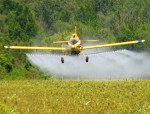 Glyphosate spraying (Photo: Roger Smith/flickr.com)
Glyphosate spraying (Photo: Roger Smith/flickr.com)
Colombia will change its strategy in the fight against illegal drugs by giving land to farmers who grow food crops instead of coca, President Juan Manuel Santos announced as the country stops fumigating coca crops with the herbicide glyphosate. Part of the new anti-drug policy is to provide poor campesinos alternatives to illicit coca crops, the raw material for cocaine, by funding the cultivation of legal crops. Farmers will receive government aid and technical advice in order to undertake other agricultural projects suited to the area’s traditions. The program also includes plans to establish rural cooperative centres, which organise the storage and distribution of farmers’ produce and help them gain access to markets. Those who grow legal crops for more than five years will be granted property titles for the lands they cultivate so that they can become legal landowners. “With this programme we hope to have a twofold result: reducing the illicit cultivation and improving the living conditions of hundreds of thousands of peasants,” Santos said on Tuesday in a speech on national TV. The plan will first be implemented with some 26,000 families that produce coca in the southern provinces of Putumayo and Nariño. “Today begins a new era in the fight against drug trafficking in our country,” Santos told journalists. “If we are successful, we will cease to have such a sad distinction of being the largest exporter of cocaine. And we will be a country that cares for the environment, increases food security in the world and provides opportunities for its farmers.” He confirmed that starting on October 1, Colombia will stop fumigating coca crops with glyphosate, a method the country has used since 1994 under a coca eradication plan with financial support from the United States. In May, the Colombian government announced to halt aerial spraying after a research arm of the World Health Organization reclassified the herbicide as ”probably carcinogenic”. According to a UN report, cocaine production in Colombia had increased more than 50% from 2013 to 2014. Coca was grown on 69,000 hectares in 2014. This is 100,000 hectares less than in 2000 but cultivation has been on the rise for the past two years. More than 80% of coca is grown in just six provinces. The previous government approach of destroying crops without providing alternatives to the farmers has failed to stop drug-trafficking and only increased poverty in rural areas. Santos said the new policy is also supported by the guerrilla group Revolutionary Armed Forces of Colombia (FARC), with whom the government has been engaged in peace talks since 2012. (ab)
2015-09-21 | permalink
Civil society rejects Climate Smart Agriculture, calls for agroecology
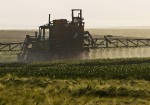 Climate-smart farming? (Photo: Erich Westendarp/pixelio.de)
Climate-smart farming? (Photo: Erich Westendarp/pixelio.de)
As climate negotiations are gaining momentum ahead of the UN climate conference COP21 in December, civil society organisations have voiced deep concerns about the growing influence of a concept called “Climate-Smart Agriculture” (CSA) and urged decision-makers to support agroecology instead. In a joint statement published on Monday, a coalition of 355 civil society groups, social movements, farmers’ and faith-based organisations from around the world warned that CSA is falling short of ensuring food and nutrition security, undermining the radical transformation of current food and agricultural systems that is urgently needed. The Global Alliance for Climate Smart Agriculture (GACSA) was launched one year ago with the aim of “addressing the challenges facing food security and agriculture under a changing climate” and “scaling up the climate smart agriculture approach”. As of 18th September, among its members were only ten developing countries and three farmers’ organisations, whereas 60% of the private sector membership of the alliance is related to the fertiliser industry, for example Yara International or Fertilizers Europe. Transnational corporations with poor environmental or social records such as Monsanto, Walmart and McDonalds have launched their own “climate-smart agriculture” programs. According to the civil society coalition, CSA is a meaningless and dangerous concept without any clear definitions, criteria or standards, thus opening the doors for greenwashing. Agribusiness corporations that promote synthetic fertilisers, industrial meat production and large-scale industrial agriculture, all of which are recognised as contributing to climate change, can call themselves climate-smart. With new instruments for international climate finance being put in place to spend billions of dollars, the coaltion fears that projects and programmes will be funded that direct resources towards false solutions. The organisations therefore urge decision-makers at national and UN levels to reject CSA and endorse agroecology as the mainstream pillar of agricultural policy frameworks worldwide. Agroecology is a holistic approach to agriculture, based on principles of ecology as well as food and nutrition security, food sovereignty and food justice which seek to enhance agricultural systems by using and recycling natural resources instead of relying on external inputs. In addition, the coalition highlight that agroecology encourages local food production by small food producers and family farmers, and is based on techniques that are developed from farmers’ traditional knowledge and practices which improve biodiversity and crop diversity. (ab)
2015-09-16 | permalink
Land degradation costs the world $10.6 trillions a year: report
 Land degradation (Photo: Julia Schäfer/pixelio.de)
Land degradation (Photo: Julia Schäfer/pixelio.de)
Land degradation costs the world trillions of dollars worth of nature’s benefits each year and could force the migration of millions of people from affected areas, a new UN-backed report has warned. The report, published on Tuesday by the Economics of Land Degradation (ELD) Initiative, estimates the value of ecosystem services provided by land such as agricultural production, water filtration, nutrients cycling and climate, but also the importance of land in reducing poverty and food insecurity. According to the authors, land degradation is costing the world US $6.3 trillion to $10.6 trillion annually, or the equivalent of 10-17% of global GDP. More than half of the world’s agricultural land is moderately or severely degraded. The report cites figures from the UN’s Convention to Combat Desertification (UNCCD), which say that land degradation may drive an estimated 50 million people from their homes within the next 10 years. “We do not value our land resources,” warns UNCCD Executive Secretary Monique Barbut, “Land degradation eats away at our fertile land. That is our common resource base.” Land degradation is not only affecting agricultural production, it also means that less land is available to to store carbon. According to the report, soil is second only to oceans as the planet’s largest carbon sink, while agriculture and land use changes represent the second largest source of greenhouse gas emissions. Addressing land degradation and its causes therefore represents a double-sided way to reduce greenhouse gas emissions, could help avert a humanitarian crisis and add US $75.6 trillion to annual world income, the authors write. They call for the implementation of more sustainable land management in order to tackle environmental and socio-economic challenges such as food, water, and energy security, climate change and the loss of biodiversity. The report recommends various instruments for policy makers to enable the adoption of sustainable land management. These include bans to ensure that products harmful to health or environmental quality such as pesticides are not used; taxes and fees to raise the cost of production or consumption of environmentally damaging goods and subsidies for those who implement sustainable land management practices. The Sustainable Development Goals (SDGs), to be adopted by the UN later this month, also focus on land resources. Goal 15 aims to “Protect, restore and promote sustainable use of terrestrial ecosystems, sustainably manage forests, combat desertification, and halt and reverse land degradation and halt biodiversity loss.” (ab)
2015-09-14 | permalink
Poor diet leading cause of early death worldwide, study finds
 Poor diets are a health risk (Photo: Klaus Steves/pixelio.de)
Poor diets are a health risk (Photo: Klaus Steves/pixelio.de)
Unhealthy eating is the most common cause of premature death across the globe, a new study has found. Poor eating habits, including diets low in fruit, whole grains, and vegetables, and diets high in red meat, sugar, sodium and cholesterol, were implicated in 21% of premature deaths worldwide because they contribute towards ischemic heart disease, strokes and diabetes. The study is the most recent update on the 2010 report on the Global Burden of Disease, which is recognised as the most authoritative work on the causes of ill-health. Published in the medical journal The Lancet on September 11, the study was led by the Institute for Health Metrics and Evaluation (IHME) at the University of Washington. “There’s great potential to improve health by avoiding certain risks like smoking and poor diet as well as tackling environmental risks like air pollution,” said IHME Director Dr Christopher Murray. “The challenge for policymakers will be to use what we know to guide prevention efforts and health policies.” The researchers looked at data from 188 countries from 1990 to 2013 and increased the number of risk factors for premature death around the world from 67 to 79 to provide a broader picture. A combination of 14 dietary risk factors contribute to the highest number of deaths worldwide, killing more people than smoking and alcohol. Dietary risks account for 11.3 million deaths worldwide and high systolic blood pressure for 10.4 million deaths, followed by child and maternal malnutrition which was responsible for 1.7 million deaths. Smoking kills 6.1 million people every year and air pollution causes 5.5 million deaths. The scientists say that risk factor patterns vary across regions and countries. In much of Latin America and the Middle East, obesity came out as the biggest risk for poor health. Drinking alcohol is the second major risk factor in Russia and smoking is the number-one risk in many high-income countries, including the UK. The situation is different for sub-Saharan Africa, which is dominated by a deadly combination of childhood undernutrition, unsafe water and sanitation, unsafe sex and alcohol use. (ab)
2015-09-10 | permalink
EU parliament votes to tighten ban on cloning farm animals
 Dolly, the first cloned sheep (Photo: Gary Henderson/flickr)
Dolly, the first cloned sheep (Photo: Gary Henderson/flickr)
The European Parliament has voted to ban the cloning of all farm animals. The vote, which took place on 8 September, takes the Commission’s proposal a step further by extending the restriction to all farm animals, their descendants and products derived from them, including imports into the EU. “Up to now, we have been able to import reproductive material from third countries. We are washing our hands letting others do the dirty work. We want to ban comprehensively. Not just the use of cloning techniques but the imports of reproductive material, clones and their descendants,” said the environment committee co-rapporteur, Renate Sommer. The draft was adopted by 529 votes to 120, with 57 abstentions. Parliament also extended the ban to cover all species of animals kept and reproduced for farming purposes and not only cattle, sheep, pigs, goats and horses, as proposed by the Commission. According to Parliament, the high mortality rates at all development stages of cloning raise significant animal welfare and ethical concerns. The lawmakers pointed to research by the European Food Safety Authority from 2008 that the health and welfare of clones are often severely affected. Many of the animals are born with abnormalities or die within the first few weeks after birth. “We need to take into account the impact on animal health, but also on human health,” said the agriculture committee co-rapporteur, Giulia Moi. “This reports sends the message to our trade partners that we are not willing to put our own health, our families’ health, and future generations’ health at stake,” she said. The vote comes amid concerns that the transatlantic trade and investment partnership (TTIP) would allow the U.S. to import cloned animal products into the EU. In the U.S., the use of clones in food production is allowed, with milk and meat from cloned animals and their offspring being sold in supermarkets. In the EU, a majority of citizens strongly oppose food from cloned animals and the use of cloning for farming purposes. MEPs of the Greens/ European Free Alliance welcomed the vote: “Clone food brings significant concerns, with impacts in areas such as livestock management and food security, but also in terms of genetic diversity and animal welfare. It would be totally irresponsible to ignore these and plough ahead with cloning as some misguided technological fix,“ said Green agriculture spokesperson José Bové. The text also demands that the legislation become a regulation, to be applied directly in all member states rather than a directive, which would require further national legislation. The co-rapporteurs will now enter into negotiations with the Council and Commission before the regulation can become law. (ab)
2015-09-08 | permalink
EU loses 970 million tonnes of soil per year due to water erosion
 The EU is losing ground (Photo: Alosh Bennett/flickr.com)
The EU is losing ground (Photo: Alosh Bennett/flickr.com)
The European Union is losing 970 million tonnes of soil per year due to water erosion, an amount equivalent to a one metre-depth loss of soil from an area the size of the city of Berlin or enough to cover an area twice the size of Belgium with one centimetre of soil. According to a new assessment from the Joint Research Centre (JRC), the European Commission’s in-house science service, an average of 2.46 tonnes per hectare of soil are lost each year across the EU while the average annual rate of soil formation is only 1.4 tonnes per hectare. As it can take up to 100 years to form just one centimetre of new soil, erosion is a major problem with a huge impact on ecosystems, food production, drinking water, carbon stocks and biodiversity. The EU country with the highest annual rate of water erosion was Italy, with 8.46 tonnes of soil per year lost, followed by Slovenia and Austria. These countries are hit hardest due to a combination of high rainfall erosivity and steep topography. The lowest mean annual soil loss rates were found in Finland with 0.06 tonnes per hectare. The JRC estimates that agricultural areas, including arable lands, permanent crops and grasslands, account for 68.3% of total soil losses, while forests account for less than 1%. Agricultural areas have a mean soil loss rate of 3.24 tonnes per hectare. Around 12.7% of arable land in the EU even loses more than 5 tonnes per hectare due water erosion. The authors recommend that policy makers promote anti-erosion measures by financing land management practices such as reduced tillage, the planting of cover crops, keeping plant residues at the soil surface, the maintenance of stone walls, and the increased use of grass margins and contour farming. With respect to the future, the scientists provide an overview of different scenarios. According to some models, the rates of soil loss by water could decrease slightly by 2050, mainly due to growing forest areas. However, an expansion of arable land for food and fuel production could offset these improvements. Other climate change scenarios project that soil loss rates may reach 10 to 15% by 2050 due to an increase of rainfall-induced erosion in Europe. The assessment of water erosion in Europe was published in the journal Environmental Science and Policy. (ab)
2015-09-03 | permalink
Andean potato varieties preserved in Arctic seed collection
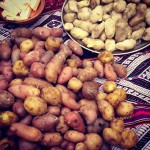 Andean potato varieties (Photo: Luigi Guarino/flickr.com)
Andean potato varieties (Photo: Luigi Guarino/flickr.com)
Potato varieties from the Andes will now be preserved for future generations in a seed vault in the Arctic. During a ceremony at the end of August, 750 potato seeds, as well as other wild potato relatives, were deposited by representatives of indigenous communities from Peru, scientists as well as FAO and Norwegian officials at the Svalbard Global Seed Vault, the world’s largest collection of crop diversity. “In a few decades, our planet's food systems will need to feed an additional 2 billion people”, said José Graziano da Silva, Director-General of the UN Food and Agriculture Organisation, who attended the ceremony. “Producing more - and more nutritious - food will be made all the more challenging as a result of climate change. Agricultural biodiversity, like that locked inside the potato seeds being deposited here, is essential to facing these challenges, by helping us develop better, more resilient crops.” The subterranean seed vault in the permafrost, 1300 kilometers beyond the Arctic Circle, currently holds over 860,000 seed samples from all over the world. The potato stems from the South American Andes, where farmers have bred over 2,000 varieties in different shapes and colours, ranging from white to deep purple. However, climate change and diseases pose a significant threat to the tuber, which is a staple food to more than a billion people worldwide. Many potato varieties have been lost in recent decades. In response, farmers and scientists have joined forces to reintroduce different potato varieties. The International Potato Centre in Peru, which holds the world’s largest potato crop collection, is partnering with local and regional initiatives to preserve the diversity of potatoes. Indigenous communities, farmers and organisations have created a Potato Park (Parque de la Papa) near the Peruvian city Cusco to maintain the cultivation of the hundreds of traditional potato varieties and keep the local knowledge of the plant alive. In order to preserve these plant genetic resources for future generations and protect them against natural or man-made disasters, the potato seeds were safely stored at a temperature of 18 degrees below zero. "These seeds, and The Potato Park farmers who are the innovators and leaders of their preservation, have been on a remarkable journey - travelling over 11,000 kilometres from the mountains of Peru to Svalbard,” said Alejandro Argumedes from non-profit organisation Association ANDES, who represented the Andean communities at the ceremony. (ab)
2015-09-01 | permalink
Climate change may affect humus content of soils, study warns
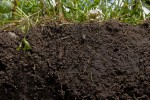 Healthy soil (Photo: NRCS Soil Health/flickr.com)
Healthy soil (Photo: NRCS Soil Health/flickr.com)
Climate change may be leading to a decline in the humus content of soils, affecting agricultural production worldwide. Scientists from the Technical University Munich (TUM) suspect that the input of organic matter into the soil, the crucial source for humus formation, will decrease as a result of stagnating crop yields in Europe. For the study, which was published in the journal Science of the Total Environment, they analysed crop yield statistics provided by the UN Food and Agriculture Organisation (FAO) which are dating back to the 1960s. The statistics indicate that yields of wheat, barley and maize have been stagnating in Central and Northern Europe since the 1990s. According to soil expert Dr Martin Wiesmeier, the lead author of the study, the stagnation in yields must also have an impact on the humus stocks in soils due to the strong link between crop yields and the input of organic substances into the soil. Given that rising temperatures cause higher levels of humus decomposition while, at the same time, the supply of organic substances is stagnating, the scientists expect a depletion of the humus content in the long term. This could negatively impact the fertility and water storage capacity of soils, which in turn could result in poorer harvests – a “vicious circle” according to Wiesmeier. The authors of the study attribute the stagnation of yields to different factors. One reason could be a shift in priorities in the EU common agricultural policy of the 1990s, due to which less fertiliser was used and leguminous plants were often excluded from crop rotation cycles. However, climate change could have a major impact with temperatures increasingly exceeding the optimum level for plant growth, shifting vegetation periods and more frequent droughts. Other studies had predicted an increased organic matter supply to soils as a result of climate change. In order to prevent the loss of humus, the scientists call for the promotion of agricultural practices that increase soil organic matter: “These include the diversification of crop rotation, the application of green manure and winter greening to reduce soil erosion, optimised soil cultivation, organic farming, agroforestry, and leaving crop residues on fields,” explains co-author Dr Rico Hübner. (ab)
2015-08-27 | permalink
Syngenta granted patent on conventionally bred tomato
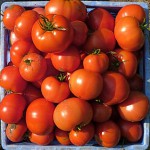 Who invented tomatoes? (Photo: Normanack/flickr.com)
Who invented tomatoes? (Photo: Normanack/flickr.com)
Agrochemical giant Syngenta has received a new patent on a tomato derived from classical breeding. The European Patent Office (EPO) granted a patent for a tomato with a higher content of compounds called flavonols to the Swiss company. Flavonols are known for their health benefits and are said to help prevent cardiovascular diseases and certain cancers. Patent EP1515600, which was published in the August 12th issue of the European Patent Register, covers the tomato plants, seeds and fruits. The “invention” is described as “flavonol expressing domesticated tomato and method of production”. The tomato was developed by crossing wild tomatoes with domesticated varieties and is thus not genetically engineered. Although European patent law prohibits patents on plant varieties and classical breeding methods, the Enlarged Board of Appeal of the EPO ruled in March 2015 in a long-awaited decision on the precedent cases of broccoli and tomato, that plants obtained by essentially biological processes are patentable. No Patents on Seeds!, an international coalition of several hundred organisations from all over Europe, strongly disapproves of this decision and the latest tomato patent, which they consider an unacceptable interpretation of patent law. “By granting these patents, the EPO is ignoring the interests of the general public and simply serving the interests of the patent lobby. If this continues we will all become more and more dependent on a few big international corporates such as Monsanto, Syngenta and Dupont, that file more and more patents on our food plants,” said Christoph Then for No Patents on Seeds! The EPO gains its revenue by granting patents. The coalition, which is supported by organisations such as Greenpeace, GeneWatch, The Berne Declaration, Swissaid and Misereor, calls on European governments to raise the issue in the Administrative Council of the EPO, the only body that could exercise political control over the Patent Office. They hope that by voicing their protest there, governments could stop the EPO from granting further patents of this kind. No Patents on Seeds! is advocating for a revision of European Patent Law to exclude breeding material, plants and animals and food derived thereof from patentability. “Otherwise we will all see the sell-out of the resources needed for our daily food,” Then said. (ab)
2015-08-24 | permalink
Study finds link between neonicotinoids and honeybee colony losses
 Bee at work (Photo: Stuart Williams/flickr.com)
Bee at work (Photo: Stuart Williams/flickr.com)
A new study provides evidence of a link between neonicotinoid pesticides and honeybee colony losses. The study led by Fera, a former UK government agency of the Department for Environment, Food and Rural Affairs, combined large-scale pesticide usage and yield observations from oilseed rape fields in England and Wales with data on honeybee loses between 2000 and 2010. According to the research, published in the journal Nature Scientific Reports on Thursday, the total area of land planted with oil seed rape in England and Wales more than doubled from 293,378 hectares to 602,270 hectares over that period. At the same time, the number of seeds treated with Bayer’s imidacloprid pesticide increased from less than 1% of the area planted in 2000 to more than 75% of the area planted with oilseed rape in 2010. The scientists found that farmers who used neonicotinoid seed coatings subsequently used less insecticides to control pests. However, more honey bee colonies were lost as the usage of imidacloprid increased over the 11 year period. The authors said that honey bee colony losses were also linked to adverse weather and showed regional patterns, with beekeepers in Wales suffering the highest losses. Honeybees are important pollinator, being responsible for pollinating at least 90% of commercial crops, especially oilseed rape. The authors conclude: “As long as acute toxins remain the basis of agricultural pest control practices, society will be forced to weigh the benefits of pesticides against their collateral damage. Nowhere is this tension more evident than in the system with the world’s most widely used insecticide, the world’s most widely used managed pollinator and Europe’s most widely grown mass flowering crop.” A European-wide two year ban on neonicotinoids linked to bee deaths came into effect in December 2013. However, the British government temporarily overturned the ban last month on two pesticides for use on oilseed rape. (ab)

